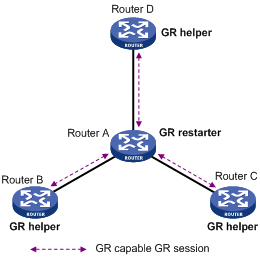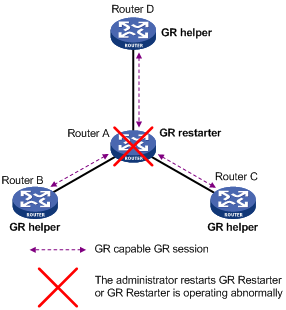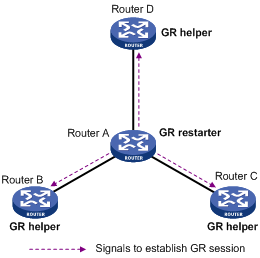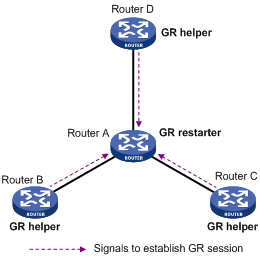- Table of Contents
-
- 08-System Volume
- 00-System Volume Organization
- 01-Login Configuration
- 02-Basic System Configuration
- 03-Device Management Configuration
- 04-File System Management Configuration
- 05-SNMP Configuration
- 06-RMON Configuration
- 07-MAC Address Table Management Configuration
- 08-System Maintaining and Debugging Configuration
- 09-Information Center Configuration
- 10-PoE Configuration
- 11-Track Configuration
- 12-NQA Configuration
- 13-NTP Configuration
- 14-VRRP Configuration
- 15-HA Configuration
- 16-Hotfix Configuration
- 17-GR Overview
- Related Documents
-
| Title | Size | Download |
|---|---|---|
| 17-GR Overview | 132.07 KB |
Table of Contents
Introduction to Graceful Restart
Basic Concepts in Graceful Restart
Graceful Restart Communication Procedure
Graceful Restart Mechanism for Several Commonly Used Protocols
Go to these sections for information you are interested in:
l Introduction to Graceful Restart
l Basic Concepts in Graceful Restart
l Graceful Restart Communication Procedure
l Graceful Restart Mechanism for Several Commonly Used Protocols
![]()
Throughout this chapter, the term router refers to a router in a generic sense or a Layer 3 switch running routing protocols or MPLS protocol.
Introduction to Graceful Restart
Graceful Restart ensures the continuity of packet forwarding when a protocol restarts.
The mechanism of Graceful Restart works as follows: When the protocol on a device restarts, the device will notify its neighbors to temporarily preserve the routing information and adjacency relationship with the device. After the protocol restarts, the neighbors will help the restarting device to update information (including various topology, routing and session information maintained by routing/MPLS related protocols that support Graceful Restart) and to restore it to the state prior to the restart in minimal time. No route flapping occurs during the restart, the packet forwarding path remains the same, and the whole system can forward data continuously. Hence, it is called “Graceful Restart”.
Basic Concepts in Graceful Restart
A router with the Graceful Restart function enabled is called a Graceful Restart-capable router. It can perform a Graceful Restart when its routing protocol restarts, ensuring consistent forwarding services. Routers that are not Graceful Restart capable will follow the normal restart procedures after a routing protocol restart.
l GR Restarter: Graceful restarting router, the router whose routing protocol has restarted due to administrator instructions or network failure. It must be Graceful Restart capable.
l GR Helper: The neighbor of the GR Restarter. It helps the GR Restarter to retain the routing information. It must be Graceful Restart capable.
l GR Session: A Graceful Restart session, which is the negotiation between the GR Restarter and the GR Helper. A GR session includes restart notification and communications during restart. Through this session, GR Restarter and GR Helper can know the GR capability of each other.
l GR Time: The time taken for the GR Restarter and the GR Helper to establish a session between them. Upon detection of the down state of a neighbor, the GR Helper will preserve the topology or routing information sent from the GR Restarter for a period as specified by the GR Time.
Graceful Restart Communication Procedure
Configure a device as GR Restarter in a network. This device and its GR Helper must support GR or be GR capable. Thus, when GR Restarter restarts, its GR Helper can know its restart process.
![]()
In some cases, GR Restarter and GR Helper can replace each other.
The communication procedure between the GR Restarter and the GR Helper works as follows:
Figure 1-1 A GR session is established between the GR Restarter and the GR Helper

As illustrated in Figure 1-1, Router A works as GR Restarter, Router B, Router C and Router D are the GR Helpers of Router A. A GR session is established between the GR Restarter and the GR Helper.
2) Restarting GR Restarter
Figure 1-2 Restarting process for the GR Restarter

As illustrated in Figure 1-2. The GR Helper detects that the GR Restarter has restarted its routing protocol and assumes that it will recover within the GR Time. Before the GR Time expires, the GR Helper will neither terminate the session with the GR Restarter nor delete the topology or routing information of the latter.
3) Signaling to GR Helper
Figure 1-3 The GR Restarter signals to the GR Helper(s) after restart

As illustrated in Figure 1-3, after the GR Restarter has recovered, it will signal to all its neighbors and reestablish GR Session.
4) Obtaining topology and routing information
Figure 1-4 The GR Restarter obtains topology and routing information from the GR Helper

As illustrated in Figure 1-4, the GR Restarter obtains the necessary topology and routing information from all its neighbors through the GR sessions between them and calculates its own routing table based on this information.
Graceful Restart Mechanism for Several Commonly Used Protocols
The device supports Graceful Restart based on Border Gateway Protocol (BGP), Open Shortest Path First (OSPF), Intermediate System to Intermediate System (IS-IS), Label Distribution Protocol (LDP).
For the implementation and configuration procedure of the Graceful Restart mechanism of the above protocols, refer to BGP Configuration, OSPF Configuration, and IS-IS Configuration in the IP Routing Volume and MPLS Basics Configuration in the MPLS Volume.

